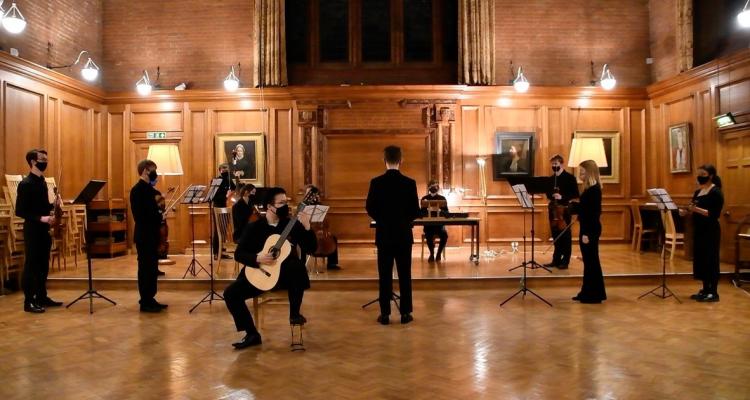Girton College Orchestra directed by Robert Jones
Battalia à 10 – Heinrich Biber (1644–1707)
- Sonata
- Die liederliche Gesellschaft von allerley Humor
- Presto
- Der Mars
- Presto
- Aria
- Die Schlacht
- Adagio. Lamento der Verwundten Musquetirer

Composed in 1673, Heinrich Biber’s Battalia was rediscovered in the 1970s and popularised during the resurgence of interest in lesser-known Baroque composers among ‘historically informed’ performers. Until then, Biber was remembered primarily as perhaps the most exceptional violinist of the seventeenth century, and as one of the first composers to write for violin solo. His use of scordatura (retuning of strings) in his Rosary Sonatas reveals an interest in extended string techniques, explored further in the Battalia. Depicting the various stages of a battle, the piece is in eight movements, with the first, third, and fifth acting as preambles to programmatic sections. The second movement, whose title translates as ‘The debauched society of all types of humour’, is a quodlibet, a great racket of different German, Slovak, and Czech folksongs bellowed by drunk mercenaries in their camp. In ‘Der Mars’, referring to the Roman god of war, Biber instructs the bass player to place a sheet of paper between the strings to imitate the snare drum, whilst the violin imitates a fife. The ‘Aria’ is a moment of peace at dawn before the chaotic musket-fire of ‘The Battle’ begins, and the ‘Lament for the Fallen Musketeers’ that follows is a moment of pathos devoted to those killed on the battlefield. It ends an otherwise jovial piece on a melancholy note.
Vivaldi composed this concerto around the year 1730 for the lutenist Johann Joseph von Wrtby. Written in the last period of Vivaldi’s highly successful career, the piece is cast in the form of a typical Italian concerto, with alternating solo and ripieno textures and a three-movement, fast-slow-fast layout. The second movement frames the soloist in two long melodies which ebb and flow with long suspensions, and is a particularly beautiful example of Vivaldi’s slow movements. There is some debate about the type of lute Vivaldi intended for this concerto, since the German lute with which the Bohemian von Wrtby would have been familiar differs vastly from the Italian lute as played in Vivaldi’s Venice. Kevin Loh sidesteps this discussion by playing the concerto on guitar, the most common solution today.
Mozart composed this spirited Divertimento in Salzburg in the winter of 1772. The young composer, just 16, had recently returned from two trips to Italy where he experienced some operatic success, and where he would return later that year for the premiere in Milan of Lucio Silla. The Italian influence is apparent in this Divertimento, which has a lightness of touch and uses a fast-slow-fast layout of movements borrowed from the Italian sinfonia. This lightness is characteristic of Mozart’s divertimentos and serenades, which were typically performed at social functions at the homes of Salzburg’s elite or, on occasion, outside. For what is essentially background music, this music is wonderfully inventive and more than a little earwormish.
| Violin 1 | Violin 2 | Viola | Cello | Bass | Continuo |
|---|---|---|---|---|---|
| Louie McIver | Emma Scott | Thomas Beauchamp | Alice Rivers | Joe Wardhaugh | Tom Williamson (harpsichord) |
| Thomas Lack | Ella Henry | Felix Elliot | Kevin Loh (guitar) | ||
| Marika Niihori |
This orchestral programme was recorded in Girton College’s Great Hall on Saturday 14 November 2020. The recording, and the preceding rehearsals, took place at a time of restrictions on communal music making and, as a result, there was no audience for this performance. There was also no opportunity to bring in players from outside College – a contrast to most student concerts in Cambridge. The conductor of the orchestra, Robert Jones, wrote the following notes about the challenges of putting the project together:
Perhaps the biggest challenge in organising an orchestral concert during lockdown was doing so ‘in the dark’ – that is, not knowing the circumstances in which the concert would take place. The fear that circumstances might change drastically at short notice was confirmed when a second lockdown was announced exactly two weeks prior to the concert. A concert with audience was modified to a recorded playthrough, which was approved only minutes before the first rehearsal took place, and only with the kind support of the Mistress. As much of the groundwork had been laid weeks beforehand, the situation was particularly frustrating. Once it was approved, however, the reduction of the orchestra to just strings made social distancing relatively easy, and the rehearsal period ran like normal, albeit with a conspicuous lack of tea and biscuits.
Robert adds a message to all members of College, junior and senior:
If you would like to join Girton’s orchestra, email Rob Jones (rj410@cam.ac.uk). The orchestra plays a concert every term, including at the coming term’s May Week Concert, where we hope to perform Bizet’s L’Arlesienne Suite No. 1 and other music. The orchestra relies exclusively on players from Girton, so do get in touch!
We are indebted to Jeremy West for recording the concert and for devoting many hours to the post-production process.